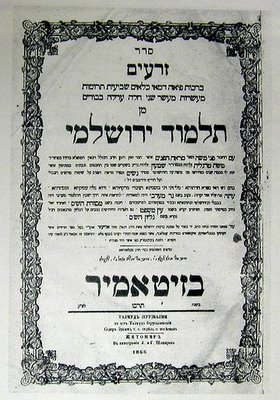
For centuries, folios of the Jerusalem Talmud languished in the backs
of libraries acquiring dust and being opened only by leading rabbinic
sages and Talmudic scholars. Mesorah Publications, whose English and
Hebrew translations and elucidations of the Babylonian Talmud have been
credited with enabling Talmud study among the masses, is now embarking on
a similar effort for a more complex text - the Jerusalem Talmud.
Completed between the years of 200-350 CE, the Jerusalem Talmud, like
the Babylonian Talmud, serves as a compendium of discussions based on
the Mishna between the sages living in the northern parts of the land of
Israel. Written in Israel, it places a far heavier focus on issues of
tradition surrounding the land of Israel than does the Babylonian Talmud
- a fact which makes it even more relevant for the large Jewish
presence in modern day Israel.
Written in an environment of persecution and harsh anti-Jewish
activity, the Jerusalem Talmud is viewed as a reflection of the Jewish
community to persevere with Torah study in the face of spiritual enemies. After
five generations, the drafting of the text was put to an end when the
Jewish community was forced into exile by the Romans. So unlike its
Babylonian counterpart, the Jerusalem Talmud was never able to be edited
and reworked in a manner that would make it more easily understood.
For ensuing generations, the Jerusalem Talmud, or the Yerushalmi, as it
is more commonly known, was a "closed book" to the majority of world
Jewry. Incorporating a dialect of Aramaic far less common than that used
in Babylonia, few students were able to decipher it. The text became
increasingly less studied, and today the Yerushalmi is rarely found in
the curricula of mainstream yeshivot. Talmudic scholars also point to the
absence of the line by line commentary of Rabbi Shlomo Yitzhaki
(Rashi), whose elucidation on the Babylonian Talmud is an indispensable
resource in appreciating the original intent of the text.
It is for these reasons that the publication of Mesorah's Artscroll
series is being viewed with such significance. In the introduction to this
first volume of the Jerusalem Talmud, the publishers describe their
effort as one which "will unseal the gates of one of the most vital
portions of the Oral Torah."
Indeed, for Talmudists and students all over the world, one cannot
overestimate the impact the Artscroll series has had upon Talmudic
scholarship. The completion of the English elucidation of the Babylonian Talmud
in 2005 resulted in more than 70,000 people around the world relying on
Artscroll for their Talmud Study.
Estimated to be completed in about 10 years, the elucidation of the
Jerusalem Talmud, which has begun with the release of tractate Berachos,
will largely adhere to the format popularized with Artscroll's
Babylonian Talmud. Each new discussion is introduced with a clear explanation of
the issues at hand. Unlike more outdated translations of the Talmud,
Artscroll relies upon a modern and easily understood style of English to
break down the often quizzical terminology utilized by the Talmudic
sages. Each line of text is elucidated using bold script to directly
translate the text, complimented by insertions of regular script to make the
intent of the text more understandable. This formula, already familiar
to the thousands who have been using Artscroll's Babylonian Talmud for
years, will make the transition to the Jerusalem Talmud relatively
easy.
A new footnote section called variants is also an excellent addition.
According to the series editors, this section was born out of necessity
to address the many instances where commentators present explanations
on the text that deviate greatly from the traditionally accepted
commentaries.
While some Jewish studies educators (this author's high school Talmud
instructors, for example) feared the Artscroll series would provide an
easy way out for students looking to avoid the challenges represented by
the Talmud, most have been convinced that the elucidation of these
texts has allowed many more people to become involved with Talmud study
than in generations past. To date, available in English, Hebrew and
French, the impact of the Artscroll is only beginning to be felt, and the
Jerusalem Talmud will serve as an additional measure of its role.
Revolutions like these in Jewish scholarship are rare and can often
only be best appreciated with considerable hindsight. Yet in the
relatively short amount of time that Artscroll Talmuds have been appearing in
study halls and Jewish homes around the world, it is clear the Mesorah
publishing house has offered a valuable contribution to the spread of
Jewish study.
By unmasking this vast yet historically under-appreciated text of the
Talmudic period, this series is sure to be recognized as an important
and necessary step in the evolution of Jewish scholarship.

No comments:
Post a Comment